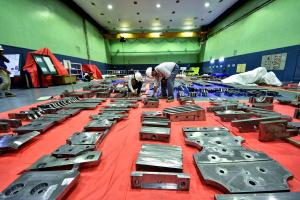In the space between the inner and outer shells of the ITER vacuum vessel are tightly sandwiched stacks of borated or ferromagnetic steel blocks that serve a double purpose: shielding components outside of the vessel from fusion neutrons and helping to optimize plasma performance by reducing toroidal field ripple.
The Indian Domestic Agency has been in charge of the procurement and delivery of approximately 9,000 shielding blocks, mainly for installation into the vacuum vessel sectors during the fabrication process in Korea and Europe. (About 10 percent of the blocks will be delivered to ITER for installation in the field joint regions when the vacuum vessel sectors are assembled in the Tokamak pit.) The weight of each neutron shielding plate can vary between 50 and 500 kg depending on its shape and location.
Manufacturing, which was carried out at M/s Avasarala Technologies Limited (ATL), Bengaluru, and Larsen & Toubro (L&T), Surat, required various industrial processes like water jet cutting, precision machining, assembly with tight tolerances, accurate dimensional measurements, spot welding, full penetration welding, and non-destructive testing.
"The design, manufacturing, and installation were challenging because of the variety of design configurations and the tight tolerance requirements," explains Chang Ho Choi, head of the Sector Modules Delivery & Assembly Division at ITER and leader of the Vacuum Vessel Project Team. "Thanks to very constructive collaboration between the Domestic Agencies of India, Europe, and Korea and their industries, we have overcome the challenges. Almost 50 percent of the installation of in-wall shielding into the sectors has been completed and the first factory and site acceptance tests (on
sector #6) have demonstrated that the quality of the in-wall shielding is quite good."


